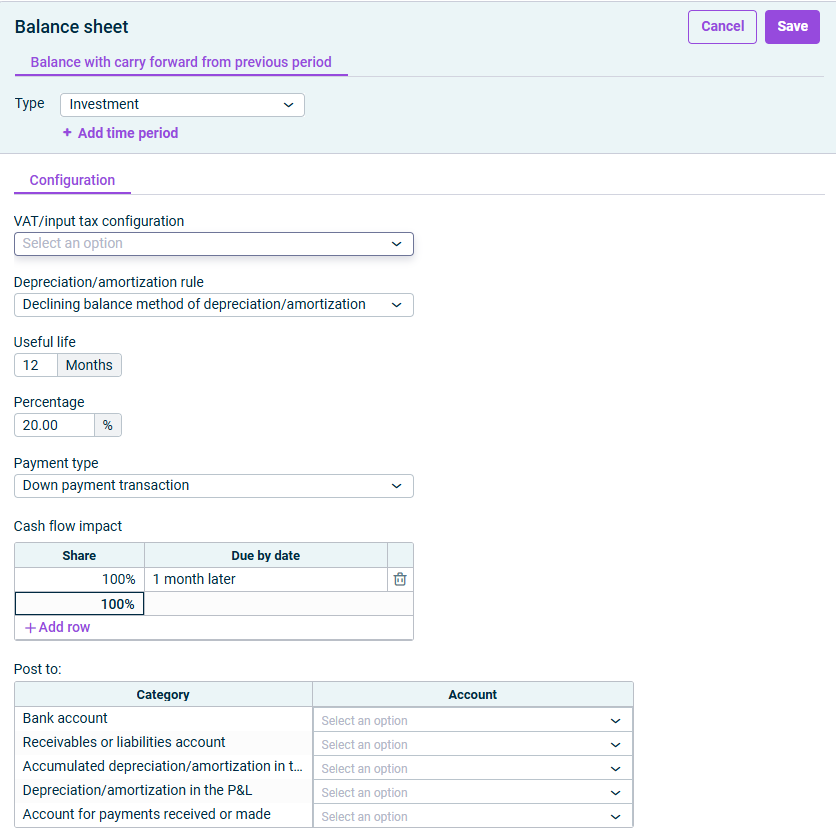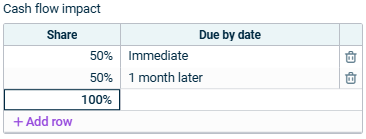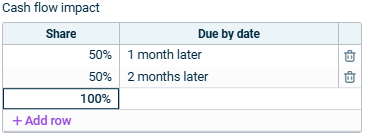Configuring Investments
Last updated on 2025-07-02
Overview
The Investment accounting rule type can be used to plan new investments and their depreciation/amortization. The configuration specifies the bank account, value-added tax and cash flow impact. Furthermore, the rule including the useful life and the accounts for the accumulated depreciation/amortization in the balance sheet and the expense in the P&L are determined.
This article contains the following sections:
Configuring Investments
To configure an accounting rule of the type Investment:
- In the dimension bar, select the combination of data level and reporting entity for which the accounting rule should apply.
- In the tree view, select the desired element (ledger, account, or item).
- Click Edit in the top right to open editing mode.
- If you selected a ledger, open the Balance with carry forward from previous period tab.
- Select Investment as the accounting rule from the Type drop-down list.
- Add or delete a time period to, e.g., configure seasonal differences within a planning period.
Notes on the Add/Delete time period options:
- Newly added time periods are displayed on the Configuration tab.
When deleting a time period, the currently selected tab is always deleted.
Options on the Configuration Tab
The following options are available on the Configuration tab:
Optionally, you can select a VAT/input tax configuration from the drop-down list (see VAT/input tax administration).
The following depreciation/amortization rules are available:
Rule
Description
No depreciation/ amortization
If the investment is not to be depreciated/amortized
Immediate depreciation/ amortization
If the depreciation/amortization is to take effect immediately
Straight-line depreciation/ amortization
If the investment is to be depreciated in equal monthly amounts over its useful life
Declining balance method of depreciation/ amortization:
If the investment is to be depreciated using a fixed annual percentage rate
In the Useful life field, you can enter the term of the depreciation/amortization in months.
This field is only visible if you selected either Straight-line depreciation/amortization or Declining balance method of depreciation/amortization.
In the Percentage field, you can enter the percentage for calculating the annual depreciation/amortization amount.
This field is only visible if you selected Declining balance method of depreciation/amortization.
The following payment types are available:
Payment type
Description
With immediate cash flow impact
If the payment will be received or made within the same month
Time-delayed payment
If the incoming or outgoing payments are made at different times
Down payment transaction
If a down payment is required when the transaction is completed
The Cash flow impact section is only visible if you selected Time-delayed payment or Down payment transaction from the payment type drop-down list.
In the Cash flow impact section, specify a due date for the payment, along with percentage of the outstanding receivable or liability to be paid in each case.
Column
Configuration
Due by date
- Enter 0 for immediate payments.
- Enter a positive number for a subsequent payment, e.g. 2 = 2 months later.
- Enter a negative number for an earlier payment, e.g. -2 = 2 months earlier.
To see an example of how average incoming payments can be entered on the Month basis, check Cash Flow Example.
Share
Enter what percentage of the outstanding receivable or liability will be paid by the specified date.
Cash Flow Example
Specify the accounts to which postings will be made in the Post to section.
The accounts to be specified depend on the chosen depreciation/amortization rule and the payment type.
Depreciation/amortization rule
Description
No depreciation/ amortization
- Bank account: An account for the contra entry
- Receivables or liabilities account: An account to which the corresponding value is posted until the cash flow impact takes effect.
(Only with time-delayed payment type)
Immediate, straight-line and declining balance method of depreciation/ amortization
- Bank account: An account for the contra entry
- Receivables or liabilities account: An account to which the corresponding value is posted until the cash flow impact takes effect
(Only with time-delayed payment type) - Accumulated depreciation/amortization in the balance sheet: An account used for correcting the asset value reduced by depreciation
- Depreciation/amortization in the P&L: An account where the depreciation/amortization is to be posted
(Only with time-delayed payment type) - Account for payment received or made: An account to which the down payment will be posted until the service is provided
(Only with down payment transaction payment type)



